Having a passion for pulses in the heart of legume season
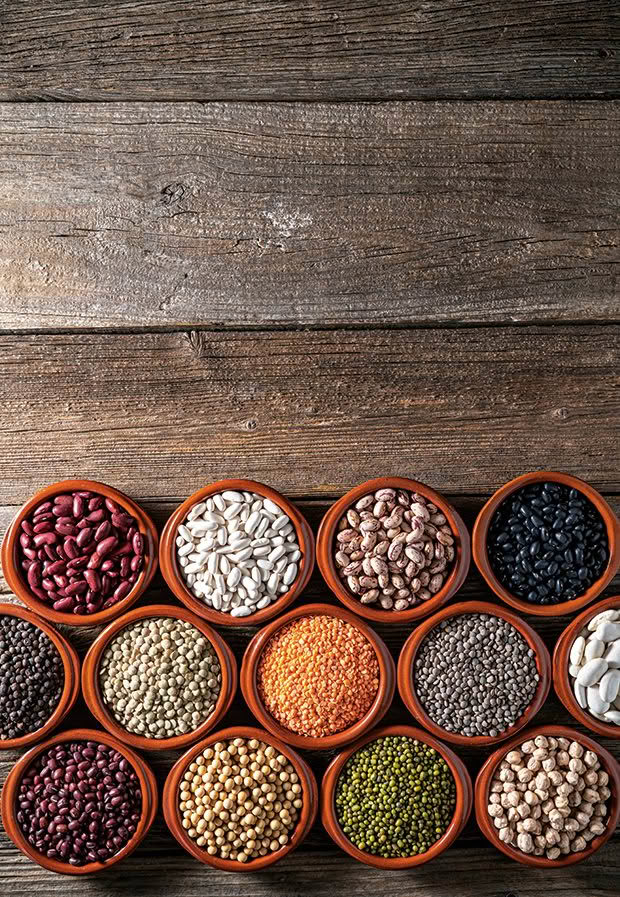
In celebration of legume season, Angela Clifford shares the ins and outs of growing these fantastic crops.
Words and photos: Angela Clifford
November is the month for legumes. Whether you’re harvesting broad beans or chickpeas, or planting bush or climbing beans, it’s a moment to acknowledge what useful and nutritious crops these are. Some clever thinking now can see them contribute to many meals for the next twelve months.
Legumes (Fabaceae) are part of an extraordinary family of plants which produce edible seeds called pulses. They are rich in protein, fibre and carbohydrates, and a good source of B vitamins, folate, calcium, potassium, phosphorus, iron, and fibre. They feature globally in a broad range of cuisines from the Middle East (think hummus) to Europe (cassoulet), Japan (edamame), China (tofu), India (dahl)
and of course a huge range of dishes from the Americas.
Legumes are the third largest plant family in the world with approximately 18,000 species. They’re also one of the most economically important crops, alongside grass and cereal plants (Gramineae) and the nightshade family (Solanaceae), which includes potatoes and tomatoes.
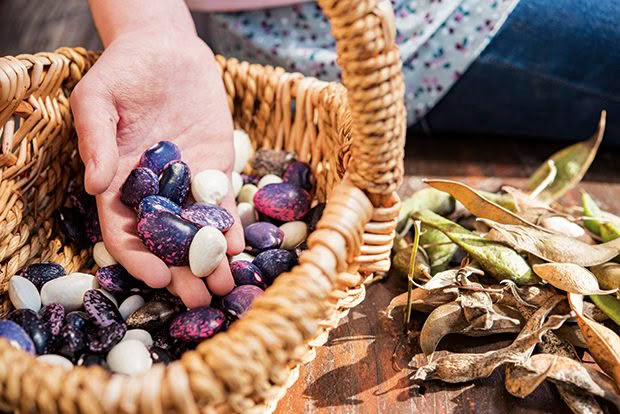
Another reason to love legumes is that they seldom cross-pollinate and are very easy to save as seed. As a result, we have some incredible heirloom bean seeds in Aotearoa, many of them brought by people from across the world as a reminder of their homelands (when that was still an allowable biosecurity option). Koanga Institute lists almost 50 different varieties of peas and beans on its farm.
Another great benefit is that all beans and legumes are nitrogen fixers. This means they contribute to your soil fertility while you grow them – a total win, win!
On The Food Farm, our speciality is “shell-out” beans, and November is the month to consider growing them. We usually get blank looks when we tell people about shell-out beans, but shell-out simply means you harvest dry from their pods for long-term storage and use. We have little bowls of them saved from last season all over the house. I mean to stash them away but they’re so beautiful to look at and running your hands through a bowl of dried beans is genuine sensory therapy!
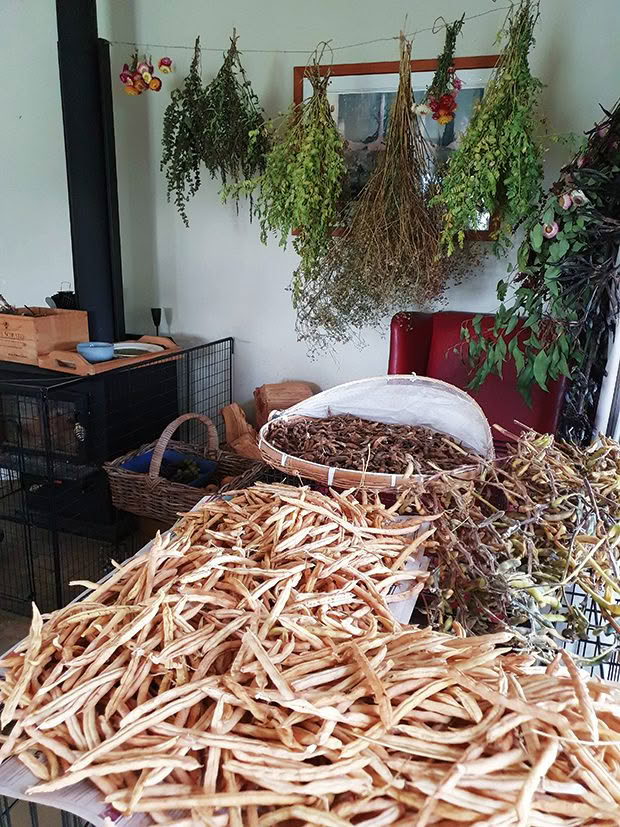
We grow a variety as shell-out beans, and this month, after the risk of a frost has passed and the soil temperature has reached new highs, I simply sow them directly in little rows wherever I have space.
Ideally you want a long, dry summer and low humidity for growing. It’s also super important to ensure they dry quickly and with little moisture so we hang them upside down once they’re picked. However, in good conditions the beans mentioned here will dry completely on the plant.
Here are a few Food Farm favourites:
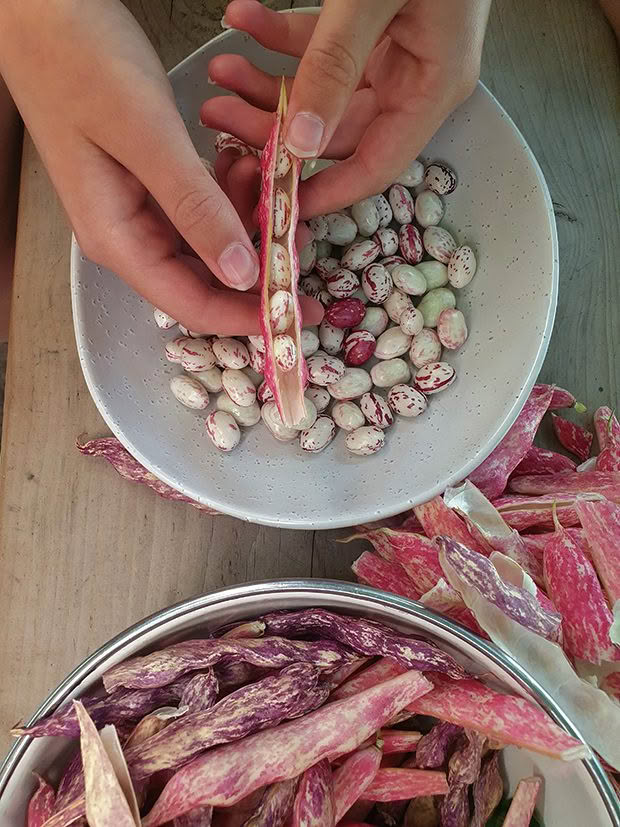
Borlotti beans.
• Borlotti bean. Also known as a cranberry bean, the borlotti bean is as versatile as it is beautiful. They’re perhaps most delicious before they’ve dried properly. We stew them gently in a flavoursome sauce with ripe homegrown tomatoes and plenty of garlic.
• Black turtle bean. This is our favourite Mexican bean for everything from tortillas and enchiladas to nachos. They grow prolifically and we cook them up with our homegrown beef mince and plenty of chillies and spices.
• Cherokee ‘Trail of Tears’. A climbing bean, this is slightly bigger and lighter than the black turtle beans. It has a beautiful and sad history as the name suggests, and we use it anywhere you’d use a black bean.
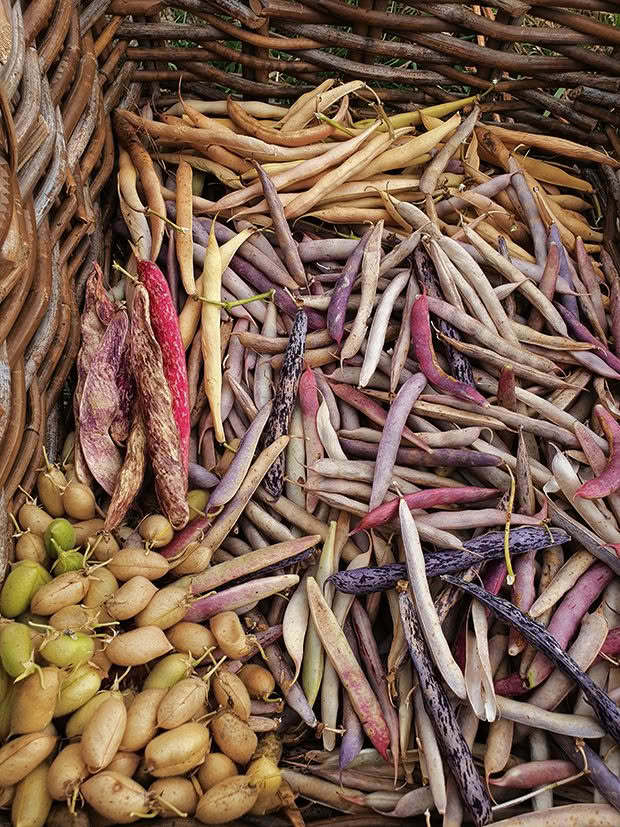
Chickpeas, borlotti and cannelini beans.
• Cannellini. Our go-to white bean for homemade baked beans, these grow as a bush bean and are as prolific as the black turtle bean.
• Butter bean. I classify these as the large white beans. Interestingly I’ve always found them hard to grow here. I’ve been given many different types over the years, but I suspect they need a longer growing season or more attention. I persist because it doesn’t take many beans to make a meal. If I succeed, I plan to mash them with olive oil and serve as a side dish.
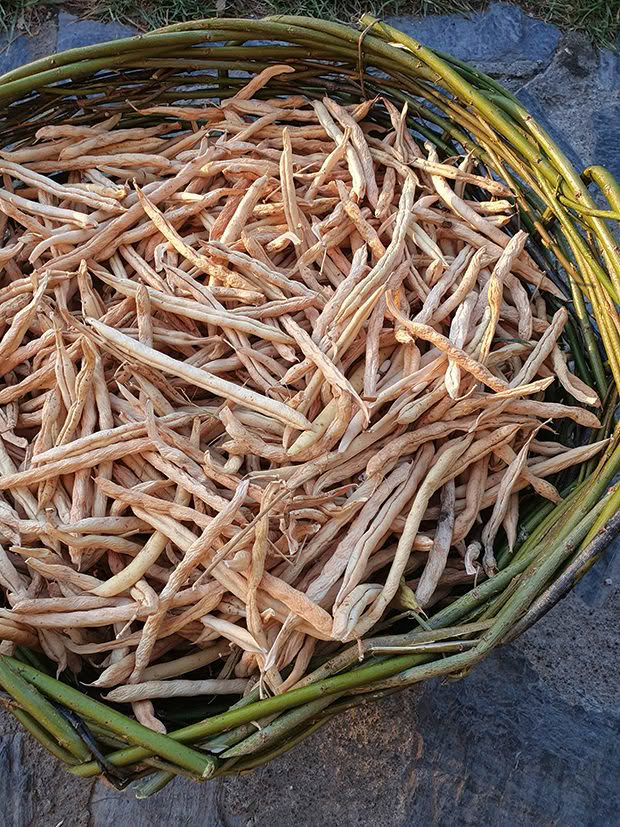
Blue Lake runner beans.
• ‘Blue Lake runner bean’. This is the bean we grow in our Three Sisters or Polyculture Paddock. It’s a voracious climber and can almost suffocate the corn until it starts to bolt. The white seeds are relatively small, but they yield an enormous quantity.
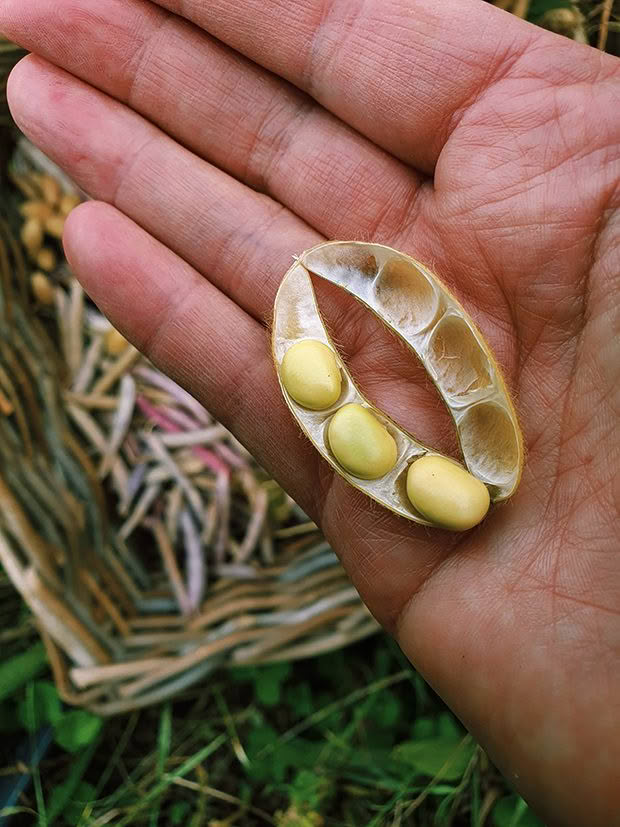
Soya beans.
• Soya bean. Every year I tell myself I’m growing this for edamame, and every year I miss my opportunity to harvest them soft and fresh, so I let them go to a dried bean and use them to make miso.
• Chickpea. This is a journey. I try every year and always get a harvest, but never enough to make a dent in our hummus consumption. I tell myself I’m saving seed and working towards a more resilient, Food Farm cultivar; we shall see where this journey leads me. I do love the plants and the surprise people get when they see how a chickpea grows.
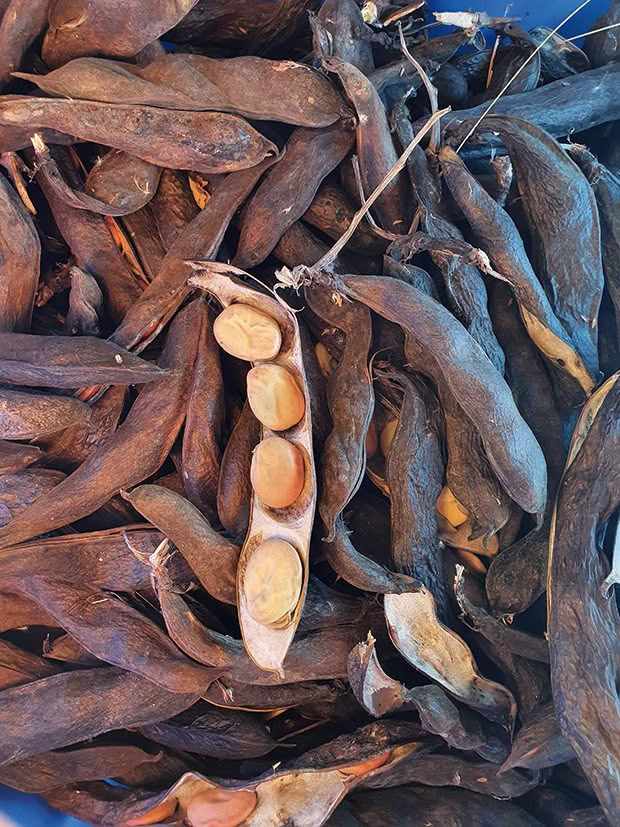
Dried broad beans in pods.
• Broad bean. These are a bit of a special case. We sow them in May and harvest them now, meaning they resolutely stand throughout the coldest and wettest of winters. Once the plants are tall enough, we nip out the growing tips and stir-fry them. They’re a “hungry gap” vegetable. Like globe artichokes and asparagus, they cheat the system and outpace the cold soil of early spring. For this reason, they’re especially important. By the end of the season the broad beans win, getting too large for us to keep up with and other harvests take over. We let the pods dry on the plants if we have room or pull the whole plant out and hang it upside down. The resulting dried beans make the most original and delicious falafel.
HISTORY OF THE CHEROKEE ‘TRAIL OF TEARS’ BEAN
The Cherokee ‘Trail of Tears’ bean is so named because the beans were carried in the pockets of the Cherokee people as they were marched from the Carolinas to Oklahoma by the Federal Government during the Trail of Tears in 1838-1839. It is estimated that thousands of Native Americans died from exposure along the way.
Broad Bean Falafel
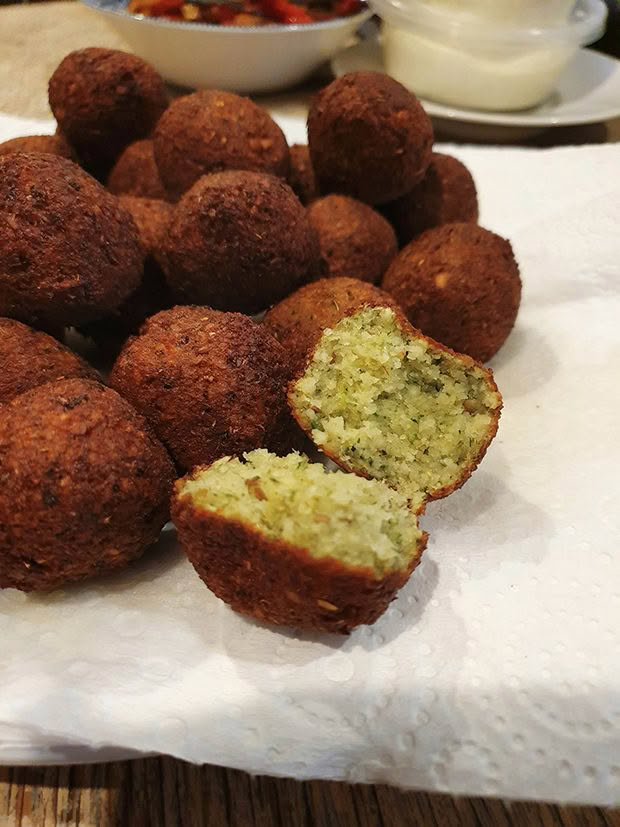
(original recipe from Claudia Roden)
This recipe comes with a bit of a warning. We have a term on The Food Farm for when something takes too much effort or “faffing about.” That term is “falafel”. I can be heard saying “It’s a bit of a falafel” on many occasions. That term has its origin from the beginning of this recipe when you arduously peel the soaked beans. But like all good falafels it’s worth the effort, and the trick is to sit down with a nice glass of wine and a good conversation while you do it.
Serves: 3-4
Prep time: 28 hours
Cook time: 1 hour
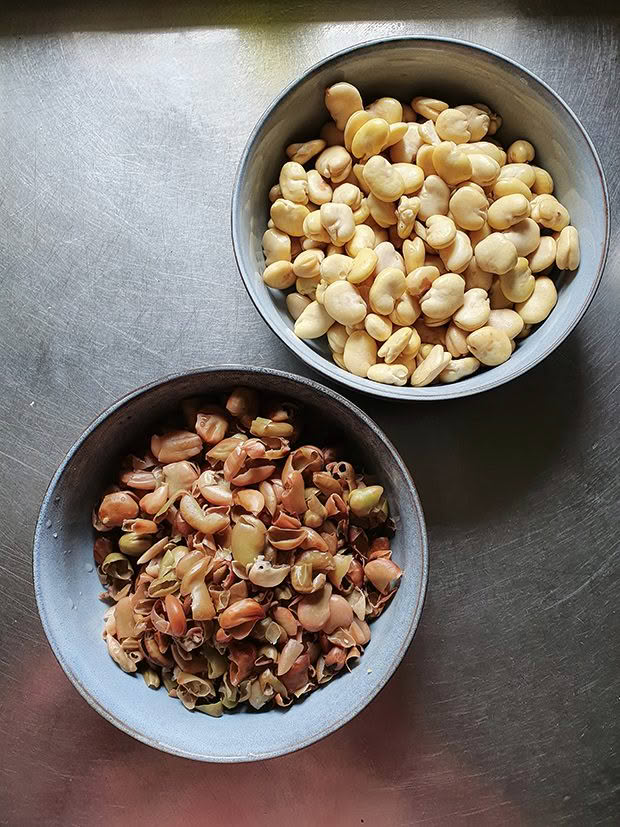
Peeled dried broad beans.
INGREDIENTS
300g dried broad beans, soaked in cold water for 24 hours, then rinsed and soaked in warm water for another two.
1 red or Spanish onion, finely chopped
1 large garlic clove, finely chopped
1 bunch of fresh parsley or coriander
2 tsp ground cumin
2 tsp ground coriander
½ tsp of baking powder
pinch of salt and cayenne pepper
NZ-made sunflower oil for deep-frying
METHOD
Peel and discard the outside skin from the broad bean seed revealing the white bean inside.
Add the beans and all other ingredients (except the oil) to a food processor and blitz. The aim is to create as smooth a paste as you possibly can. If necessary, smash the mixture up further with a stick blender. If it’s not smooth enough it won’t hold together. Let it rest for half an hour. Make walnut size balls from the mixture and then either flatten or leave as balls. Rest for another 15 minutes and then fry in oil until deep, golden brown. We don’t have a deep fryer so just put about an inch or two of oil in a pan so you don’t waste too much, make sure it’s hot before you drop them in and watch out for splashes. Drain on a paper towel.
While the falafel rests, prepare the accompaniments. We love grated carrot salad with a drop of orange blossom water, and a creamy sauce of yoghurt, tahini and garlic. You can also add a cucumber and tomato salad and lots of fresh herbs and salad leaves. We make our own flatbreads as well.
Love this story? Subscribe now!
 This article first appeared in NZ Lifestyle Block Magazine.
This article first appeared in NZ Lifestyle Block Magazine.
